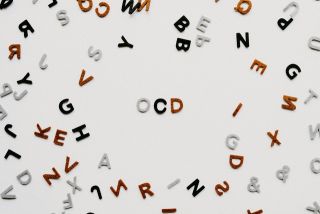Pregnancy
I Wish I Knew About Postpartum OCD When It Happened to Me
What I've learned about the effects—and treatments—for postpartum OCD.
Posted June 21, 2024 Reviewed by Tyler Woods
Key points
- Perinatal (pregnancy and postpartum) OCD is a relatively new diagnosis, and can be terrifying.
- Not long ago, postpartum OCD had little recognition or help.
- Now we have great, safe treatments for OCD during pregnancy and postpartum.

Thirty-three years ago, I had my firstborn and knew nothing about something terrible happening to me. Postpartum disorders had not yet made it into the DSM, the Diagnostic and Statistical Manual (a.k.a. bible) of Mental Disorders, so what I was experiencing essentially didn’t exist. I was a nurse-midwife, but I was terrified. Thoughts of poking my newborn in the eye with something sharp, or dropping her, intruded unbidden into mind, hitting me as I unloaded the dishwasher or climbed the stairs. I was too horrified to mention these thoughts to my care provider.
Three years later, I had my second child. The anxiety and intrusive images grew worse (as they tend to do over subsequent pregnancies, worsening like any illness over time). This time, I did mention it, and my nurse-midwife tried to reassure me, not shaming or alarming me, but she knew no more about reproductive psych disorders than I did. I didn’t find help for two more years.
Gratefully, perinatal OCD—more often known as postpartum OCD (though it can also begin in pregnancy)—is now a known entity. Yet just because the name is known doesn’t mean it’s well understood. Here’s everything I wish I’d known then. Pass it on to anyone it could help!
- You are not “crazy,” and you don’t have psychosis. You are not going to hurt your baby. I definitely feared I was going crazy, and it could have just been a matter of time before I was hallucinating or delusional. Delusions and hallucinations are part of postpartum psychosis, a much rarer and different disorder than perinatal OCD. In postpartum psychosis, women lose touch with reality and are at actual risk to themselves and their children. On the contrary, with perinatal OCD, women are in touch with reality and highly distressed by their intrusive thoughts or images. They often go to great lengths or carry out compulsions to defend against their “bad thoughts,” asking others to carry the baby on stairs, for example, or bathe and diaper them (OCD intrusive thoughts or images can be of a sexual nature).
- You may never have experienced anything like this. Did you check under the bed as a kid, an even number of times, to ensure there were no monsters? I did. Do you need everything spic and span to feel at ease, tidying up to the degree that you’ve been called a neat freak, or urged to “let it go”? Many people with perinatal OCD had OCD or its symptoms in the past. Perhaps they were treated, perhaps it never got “that bad.” Either way, perinatal OCD can arise if you’ve had OCD or you haven’t. It’s estimated 1-2 percent of perinatal women are affected by OCD. But as with any estimate of things people hesitate to talk about, this is likely an underestimate.
- Even if you had OCD, perinatal symptoms are likely different. Perinatal OCD symptoms can be especially alarming because intrusive thoughts involve the infant, the person you likely most want to protect and care for. Perinatal OCD can also lead to avoidance of baby care (such as not wanting to see the baby naked if intrusive thoughts happen during diapering), compulsions, insomnia (when sleep is so precious), and/or depression.
- It bears repeating: you won’t carry out your intrusive thoughts. Intrusive thoughts and images are so distressing in perinatal OCD we call them “ego-dystonic”—they are the exact opposite of what you truly want to do. On the contrary, with postpartum psychosis, thoughts of harm can be “ego-syntonic,” or consistent with a person’s delusions and hallucinations, and acceptable to the person experiencing them. Perinatal OCD and postpartum psychosis are two very different, separate disorders.
- OCD is driven by anxiety. OCD comes in so many varieties that the latest 2013 edition of the DSM moved OCD out of the Anxiety Disorders category and into its own Obsessive-Compulsive and Related Disorders (OCRD) category. (Skin picking, hair-pulling, hoarding, and other OCD variants are included.) But all OCD, including perinatal, predominantly causes excessive anxiety. You might be anxious to pick up the baby or drive. Maybe you’re anxious to go to bed because you’re afraid you won’t sleep. You may be anxious to cut a tomato with a sharp knife. Whatever it is, anxiety is prevalent and may be all-encompassing. The great news is, this is very treatable and you will get well.
 Source: Annie Spratt/Unsplash
Source: Annie Spratt/Unsplash - There are great treatments for Perinatal OCD. OCD is the only psychiatric disorder found not to respond to placebo. It is a true brain disorder and, luckily, responds robustly to antidepressants (and, in some cases, other medications) that have been found safe in pregnancy and breastfeeding. OCD treatment generally requires high doses of medications to be effective, and these meds definitely work. Therapy—particularly cognitive behavioral therapy, but others as well—is also effective, and in general, therapy and medications work better together than either do alone.
- It’s not me, it’s my OCD. For starters, simply recognizing what you may have is a brain issue and involves your thinking can be harnessed for healing and anxiety reduction. When intrusive thoughts or images strike, you can remind yourself, “It’s not me, it’s my OCD.” Take a deep breath, understand this is a process of healing, and try to let go of fear while doing something positive. Reach out for help, call a trusted friend, be around others who comfort you, or use your favorite self-care hack, for starters.
- Connect with others. Not only is isolation evolutionarily unnatural for humans—especially with a new baby—but being alone tends to heighten anxiety. Being with others can help you relax and validate you are doing a good job. Besides friends and family who are supportive, there are many groups for those with perinatal OCD. Online, you can join anywhere. Postpartum Support International, Maternal OCD, and Policy Center for Maternal Mental Health are national and international resources to get you started. You are not alone!
- Stop the silence. There is no shame in sharing you have perinatal OCD. It can be a relief to share, and it helps others know there’s nothing to be ashamed of. But it’s your story to tell, and you needn’t share if you don’t feel safe. Remember the great acronym S.H.A.M.E.: Should Have Already Mastered Everything. That’s a gross untruth about anyone or anything, especially a new mom. You’re doing a great job at the hardest job you’ll ever have (parenthood), and the best job you can at the moment. You are good enough!
- The quicker you find help, the better for you…and your family. The days of believing we can and should pull ourselves up by our own bootstraps are thankfully over. We know “it takes a village.” But sometimes, we think needing help only applies to others, not us. Well, it applies to us, too. Research shows mothers with psychiatric disorders risk having children with psychiatric disorders or other problems. But there’s great news: when moms get treated, their children get better. What a happy “side effect” of healing. If you’re reluctant to reach out, remember your entire family benefits. Soon, you’ll feel better. Good treatment works. I’ve never seen it fail. Go forth and heal!

To find a therapist near you, visit the Psychology Today Therapy Directory.


